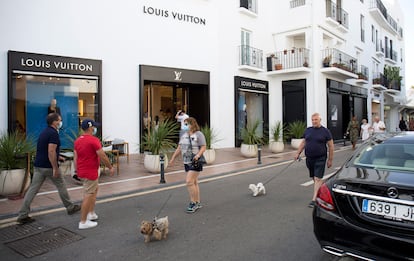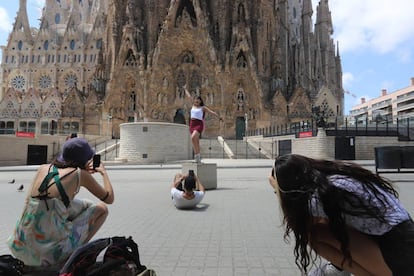Spanish tourism industry feeling the loss of high-rolling visitors
The restrictions on travel into the EU have taken a toll on Madrid, Barcelona and Costa del Sol, which are popular with tourists from Russia, Saudi Arabia, Mexico, Brazil and the US

The so-called “Golden Mile” between Puerto Banús and Marbella, on Spain’s Costa del Sol, has been left without its typical visitors this summer: tourists from the Middle East and Russia. The image of the Spanish port filled with yachts and glamorous foreigners dressed in expensive brands is now a thing of the past. Tourists from these countries are very important to the area – not because they arrive in large numbers, but because they spend large amounts of money. “They spend the most, especially in shops and restaurants,” explains one of the business owners who have reopened, albeit at half-throttle, at Puerto Banús.
Spain’s tourism industry has been in a critical state since the beginning of the coronavirus crisis, which led to a near global lockdown and strict travel restrictions. While travel is now permitted within the European Union and Schengen Area, it remains heavily restricted for citizens of countries outside the EU.
They come with their family and entourage, which could be up to 40 people, and they fill up the most expensive restaurants where they leave up to €300 in tipsEnrique García, a waiter in Puerto Banús
Before the coronavirus pandemic, the EU allowed citizens from 105 countries and territories into the Schengen Area, which comprises 26 countries, including most EU members. The number of nationalities allowed into the Schengen space has now been cut to a list of 15. The approved list leaves out 150 nations, including the United States, Russia, countries in Latin America and the Gulf states – which are important tourism markets in terms of spending. What’s more, visitors from China, which is on the EU-approved list, will only be allowed to travel to Europe if EU citizens receive reciprocal treatment.
These restrictions mean that the streets of Barcelona, Madrid and Marbella are missing visitors from Asia, the Americas, Russia and the Middle East, with their large wallets and overflowing shopping bags.
“We are missing the petrodollars,” says María Jurado, a sales clerk at an exclusive fashion brand in Puerto Banús, alluding to visitors from oil-rich nations like Russia and Saudi Arabia.
“They come with their family and entourage, which could be up to 40 people, and they fill up the most expensive restaurants where they leave up to €300 in tips,” adds Enrique García, a waiter with almost 25 years’ experience in some of the hotels in the area.
These markets are so important that some hotels have been designed especially to meet their needs. For example, there are two halal hotels aimed specifically at travelers from the Middle East in Marbella (Alanda Hotel) and Torremolinos (Luxury boutique Costa del Sol). “We don’t know when these tourists will be able to return, but this summer season has been ruined without them. The same as has happened with Russians and Americans who will not come to [Málaga] province this year,” says Luis Callejón, the president of the Costa del Sol hotel industry association.
The Spanish tourism industry came to a standstill in mid-March, when strict travel restrictions were introduced to stop the spread of Covid-19. Since then, the sector has suffered a series of setbacks. Although Spain reopened borders to EU countries at the end of June, the tourism industry continues to struggle to draw back the more than 83 million international visitors who traveled to the country in 2019, and who spent more than €90 billion.
Impact on Catalonia
Although international tourists are allowed to visit Spain, a significant number of those who normally visit – around 10% – will not be able enter the country due to the travel restrictions on non-EU countries.
“The United States, Russia, Argentina and Mexico are of utmost importance because they are the tourists who spend the most,” says José Luis Zoreda, the vice-president of the tourism lobby Exceltur.
The loss of these tourists will take the largest toll on Catalonia and Madrid. Of the 3.3 million US tourists who visited Spain in 2019, more than 1.51 million traveled to Catalonia, while around 900,000 went to the Madrid region, according to the National Statistics Institute (INE).

It is a significant blow to both regions, given that visitors from the US represent the largest tourist market in Madrid, and the third largest in Catalonia, after France and the United Kingdom. Indeed in Catalonia, tourists from the US spend more than visitors from any other country.
“Obviously the fact that US citizens can still not come affects us, but I wish that was the only problem,” says Manel Casals, the head of the Barcelona Hotel Guild. In Barcelona, only 60 hotels are open, with occupancy between 15% and 20%. This is an unprecedented situation for a city used to being inundated with tourists. The industry group believes that the situation will not improve until autumn, in the best-case scenario.
“We’ve given this year up as a lost cause,” says Gabriel Jané, the president of Barcelona Oberta, an association that represents the most important shopping hubs in the city. One of these is the Paseo de Gràcia, the home of luxury shops and an important attraction for tourists from Asia, Russia and the Middle East. But for now, there is no sign of them.
Madrid, the gateway to Europe
Madrid is also feeling the absence of tourists from Latin America. The Spanish capital is used by travelers from countries like Argentina, Mexico and Brazil as the gateway to Europe and a holiday base. “Although Madrid is not their final destination, it is a transit spot that always benefits [from passing visitors],” says Zoreda. “Lots of family tourism comes from these countries and they use the Spanish capital as a base to travel to other European cities.” According to the Madrid Hotel Business Association, these visitors usually choose hotels in the center of the city, which continue to register record-low activity due to the absence of international visitors, especially those from Mexico.
“They are the best, by far, because of the tips they leave and what they spend during their vacations,” say several sources from major hotels and luxury shops. According to 2019 figures from Planet, a financial services company specializing in the management of VAT refunds for tourists, visitors from China, the US and Russia spent the most in Barcelona, while tourists from China, the US and Mexico spent the most in Madrid.
With visitors from these countries still unable to enter the country, the Spanish tourism industry continues to struggle, with no rebound likely in the short term.
English version by Melissa Kitson.
Tu suscripción se está usando en otro dispositivo
¿Quieres añadir otro usuario a tu suscripción?
Si continúas leyendo en este dispositivo, no se podrá leer en el otro.
FlechaTu suscripción se está usando en otro dispositivo y solo puedes acceder a EL PAÍS desde un dispositivo a la vez.
Si quieres compartir tu cuenta, cambia tu suscripción a la modalidad Premium, así podrás añadir otro usuario. Cada uno accederá con su propia cuenta de email, lo que os permitirá personalizar vuestra experiencia en EL PAÍS.
¿Tienes una suscripción de empresa? Accede aquí para contratar más cuentas.
En el caso de no saber quién está usando tu cuenta, te recomendamos cambiar tu contraseña aquí.
Si decides continuar compartiendo tu cuenta, este mensaje se mostrará en tu dispositivo y en el de la otra persona que está usando tu cuenta de forma indefinida, afectando a tu experiencia de lectura. Puedes consultar aquí los términos y condiciones de la suscripción digital.
More information
Últimas noticias
Most viewed
- Oona Chaplin: ‘I told James Cameron that I was living in a treehouse and starting a permaculture project with a friend’
- Reinhard Genzel, Nobel laureate in physics: ‘One-minute videos will never give you the truth’
- Sinaloa Cartel war is taking its toll on Los Chapitos
- Why the price of coffee has skyrocketed: from Brazilian plantations to specialty coffee houses
- Silver prices are going crazy: This is what’s fueling the rally









































